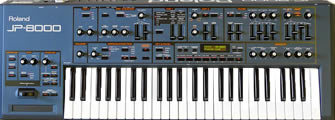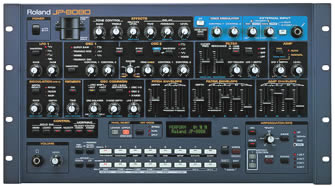Sampled Instruments
Synthesizers, Keyboards & Modules
Akai AX-73 SynthCasio CZ-101
Casio VZ-1
EDP Wasp Synth
Ensoniq SQ-1 Plus
Korg MS 10
Korg MS 20
Korg Poly-800
Novation Super Bass Station
Roland JP-8080/JP-8000
Roland Juno 1
Roland Juno 106
Roland JX-3P
Yamaha TX802
Budget Samples
Access Virus CCasio HT-6000
Cheetah MS6
Clavia Nord Lead 2X
KAWAI K1/K1m/K1r
Korg DW8000
Korg Triton
Novation Supernova II
Quasimidi Technox
Roland D 50
Roland JD800
SCI MAX / 6-Track
SIEL DK 80
Roland JP-8080 / JP-8000
 In the world of sound synthesis we first had huge modular analogue systems, then analogue keyboards and then came the digital revolution with the Yamaha DX range and Roland's sample based D50. Within a decade keyboard players were searching out the old analogue classics, such as the Roland Jupiter 8 (1981), and prices began to rise. Roland responded to this demand (in 1997), not by producing the analogue monster that was demanded but a completely digital emulation on analogue technology, in the form of the JP-8000 keyboard.
In the world of sound synthesis we first had huge modular analogue systems, then analogue keyboards and then came the digital revolution with the Yamaha DX range and Roland's sample based D50. Within a decade keyboard players were searching out the old analogue classics, such as the Roland Jupiter 8 (1981), and prices began to rise. Roland responded to this demand (in 1997), not by producing the analogue monster that was demanded but a completely digital emulation on analogue technology, in the form of the JP-8000 keyboard.
 Two years later, in 1998, Roland released a rackmount/desktop version, the JP-8080. The JP-8080 has the same sound engine (analogue modeling) as the JP-8000 but with a few interesting additions. Firstly it includes, what Roland call, a voice modulator - which is akin to a vocoder. Secondly they added two external inputs which could be used with a microphone for the vocoder and/or to run an external signal through the filter and effects of the JP-8080. Other additions include a distortion effect, oscillator 2 now has a noise option and the number of performances and patches trebled.
Two years later, in 1998, Roland released a rackmount/desktop version, the JP-8080. The JP-8080 has the same sound engine (analogue modeling) as the JP-8000 but with a few interesting additions. Firstly it includes, what Roland call, a voice modulator - which is akin to a vocoder. Secondly they added two external inputs which could be used with a microphone for the vocoder and/or to run an external signal through the filter and effects of the JP-8080. Other additions include a distortion effect, oscillator 2 now has a noise option and the number of performances and patches trebled.
Sections
More About The JP8000/JP8080
JP8000 Specifications
JP8080 Specifications
Notes About The JP8000/JP8080
Famous JP8000/JP8080 Users
JP8000/JP8080 Samples
More About The Roland JP-8000/8080
"it was just amazing I made sounds just as good and better then my Jupiter 8) you can make every sound possible on a Roland jp8000 with will replicate exact as the Jupiter 8) in the end I sold my Jupiter 8 and keep my Roland jp8000"
Today the JP-8080 remains a desirable piece of kit and even though the pots are rather flimsy the secondhand market is strong, Many of the JP critics say that it does not sound "analogue" enough but we feel that they have missed the point entirely. The Roland JP-8080 & JP-8000 are modern "Jupiters" with a sharper, edgier sound but with careful programming it can sound as rich as many of Roland's classics. The point is that they (Roland) have a vast back catalogue of instruments upon which to draw inspiration but, at the same time, Roland is always pushing synthesis forward. The JPs can pull off decent emulations of Junos but also produce some new and exciting sounds. There are many who believe that the JP is an abbreviation of the word "Jupiter" although Roland themselves never, to our knowledge, actually said this themselves.
Supersaw
The Roland JP-8000 is one of the most respected of the company's virtual analogues, famous for its use of Roland's "Supersaw" waveform (both the JP-8000 and the JP-8080 have the supersaw waveform on oscillator 1). On many old analogue polyphonic synthesizers there was the ability to use all of the oscillators on one note at the same time. Although this made the keyboard monophonic by detuning each of the oscillators it was possible to create a really thick (phatt) sound which could be used for powerful bass or lead sounds which are usually played monophonically anyway. Roland created the supersaw waveform to somewhat emulate this effect and the resulting waveform is said to emulate 7 saw waves played in unison. The waveform proved a hit amongst producers of Trance music, especially in the sub-genres of "Anthem Trance" and "Uplifting Trance" but it can be heard in a huge variety of EDM (electronic dance music) tracks.
Roland JP-8000 Specifications
- Polyphony: 8 notes at a time
- Oscillators: 2 Analogue Modeling DSP oscillators
- Osc Waveforms: Saw, Super Saw, Square (PWM), Triangle (PWM), Triangle Mod, Feedback OSC, noise
- LFO: 2 LFOs. LFO 1 features Triangle, sawtooth,square and sample and hold. LFO 2 Triangle on modulation lever only
- Filter: 12/24dB/oct low pass / band pass / hi pass with resonance,
- Effects: ring modulator, delay & chorus
- Control: Midi 2 part multitimbral, arpeggiator and real-time Phrase Sequencing (RPS)
- Keyboard: 49 velocity sensitive synth style keys
- Manufactured 1996
Roland JP-8080 Specifications
The Roland JP-8080 is the desktop/6U rack-mount module version of the JP-8000 keyboard with a few enhancements including 30 knobs, 14 slider and a huge selection of switches to create one of the finest "hands on" control interfaces available.
- Polyphony: 10 notes at a time
- Oscillators: 2 Analogue Modeling DSP oscillators
- Osc Waveforms: Saw, Super Saw, Square (PWM), Triangle (PWM), Triangle Mod, Feedback OSC, noise
- LFO: 2 LFOs. LFO 1 features Triangle, sawtooth,square and sample and hold. LFO 2 Triangle on modulation lever only
- Filter: 12/24dB/oct low pass / band pass / hi pass with resonance, 12-band formant filter bank
- Effects: ring modulator, delay, chorus, flanger, phaser, distortion and bass & treble control
- Control: Midi 2 part multitimbral, arpeggiator and real-time Phrase Sequencing (RPS)
- Manufactured 1998
Roland JP-8000/8080 Notes
One thing that many notice about the JP-8000 and the JP-8080 is that some patches start with a pronounced click. Although many assume it to be a flaw it is actually accurately modelling their own (& other) analogue synthesizers which produced this click when the envelope attack (& decay) where set to extremely fast. To remove the click simply reduce the attack speed.
Unfortunately, in common with virtually every virtual analogue we have tried the JP-8000/JP-8080 suffers from awful alaising on the higher notes. This is a terrible shame as I am sure that if the bandwidth was limited on the higher notes this would be removed and people would prefer the resulting sound far more than the useless sounds it produces as it is. Personally we use true analogue machines for higher notes or we, very carefully, program sounds to avoid this serious issue.
Roland JP-8000/8080 Famous Users
The following artists are all known to have used one of these synths: 7 Skies, Adam Nickey, Preston Boutot Zoogma, Aron Magner from The Disco Biscuits, Armin van Buuren, A Vanvranken, Blondie (Maria), Brian Transeau, Brandon Flowers (Killers), BT, Charly Garcia, Chicane, Craig Jones, Crescendo, David Bowie, Depeche Mode, Disco Biscuits, Deadsy, Duran Duran, Faithless, Ferry Corsten, Front 242, Frutilla Camarosa, Garbage, Gary Numan, Gavin Castleton, Geoff Downes, Goldie, Groove Armada, The Hitmen, James Horner, Jean Michel Jarre, Kate Ryan, Ken Ishii, KMFDM, Los Prisioneros, Luke Terry, Martin Butler, Michael Pinnella, Mike Shiver, Doll Factory, Muse, Paul Van Dyk, Pet Shop Boys, port-royal, The Prodigy, Robin Brandes, Rank 1, Scooter, Scott Brown, Robotox, The Smashing Pumpkins, Tangerine Dream, The Adjective Noun, The Automatic, The Crystal Method, Tiesto, 3 Steps Ahead, Underworld, Velvet Acid Christ, Vince Clarke, William Orbit, Secrettes, Dj Platinum and Hocico
Roland JP-8080 / JP-8000 SAMPLE PACK 1 & 2 |
|||
 |
Kontakt, EXS24 + WAV CLICK HERE to Buy at Gumroad.com
|
Contains nearly 800 JP-8080 / JP-8000 sound patches at 24-Bit PRICE: £39.99 [Download via gumroad.com] |
|
Discover more about our JP-8-8080 & JP-8000 Sample Collections >>> |
|||




